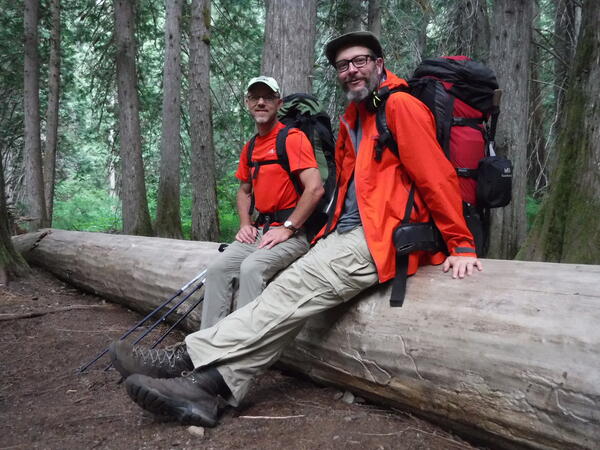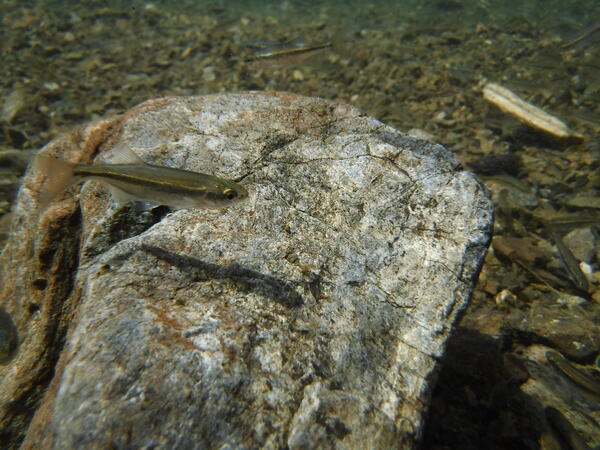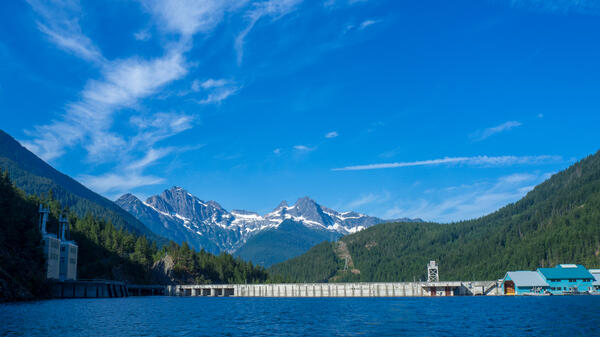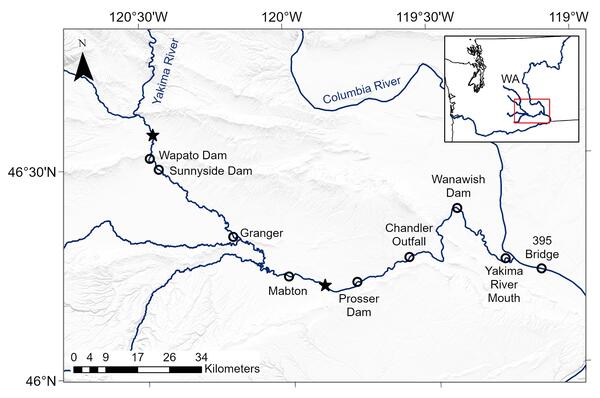These are two USGS Western Fisheries Research Center scientists, Carl Ostberg and Jeff Duda (from left to right), sitting on a fallen tree in Skagit, WA. These scientists study critical fish, like salmon, in the Ross Dam reservoir and tributaries.
Multimedia
Search here for some of our available field imagery and videos.
Images
These are two USGS Western Fisheries Research Center scientists, Carl Ostberg and Jeff Duda (from left to right), sitting on a fallen tree in Skagit, WA. These scientists study critical fish, like salmon, in the Ross Dam reservoir and tributaries.
This is a photo of a fish in Ross Lake, WA called the Redside Shiner. Ecologists at the Western Fisheries Research Center are studying this fish and the food web in Ross Lake.
This is a photo of a fish in Ross Lake, WA called the Redside Shiner. Ecologists at the Western Fisheries Research Center are studying this fish and the food web in Ross Lake.

USGS Scientists Collecting Tissue Samples from a Rainbow Trout on Ross Lake.
USGS Scientists Collecting Tissue Samples from a Rainbow Trout on Ross Lake.This is a photo of scientists, Ben Jensen and Shelley Johnson, collecting tissue samples from a rainbow trout on Ross Lake. The USGS Western Fisheries Research Center does work on Ross Lake to understand the food web and ecology for salmon.
USGS Scientists Collecting Tissue Samples from a Rainbow Trout on Ross Lake.
USGS Scientists Collecting Tissue Samples from a Rainbow Trout on Ross Lake.This is a photo of scientists, Ben Jensen and Shelley Johnson, collecting tissue samples from a rainbow trout on Ross Lake. The USGS Western Fisheries Research Center does work on Ross Lake to understand the food web and ecology for salmon.
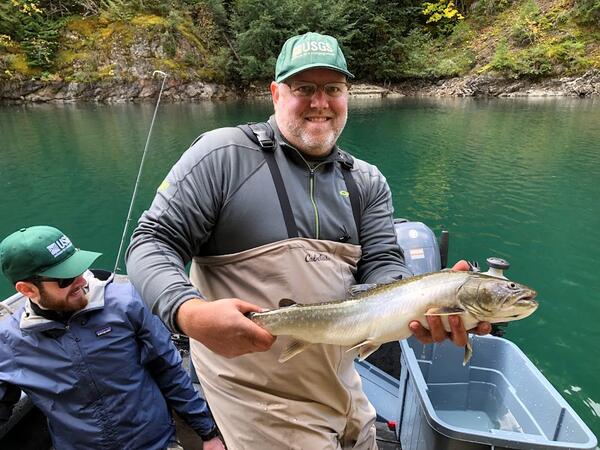
USGS Scientist Holding a Bull Trout in Ross Lake, WA
USGS Scientist Holding a Bull Trout in Ross Lake, WAThis is a photo of scientist, Marshal Hoy, holding a bull trout in Ross Lake. The USGS Western Fisheries Research Center does food web studies in Ross Lake to better understand the ecology and habitat for salmon in the area.
USGS Scientist Holding a Bull Trout in Ross Lake, WA
USGS Scientist Holding a Bull Trout in Ross Lake, WAThis is a photo of scientist, Marshal Hoy, holding a bull trout in Ross Lake. The USGS Western Fisheries Research Center does food web studies in Ross Lake to better understand the ecology and habitat for salmon in the area.
This is a photo of Ross Dam as viewed from the boat. This photo was taken by fisheries scientists from the USGS Western Fisheries Research Center.
This is a photo of Ross Dam as viewed from the boat. This photo was taken by fisheries scientists from the USGS Western Fisheries Research Center.
This is a map of the lower Yakima River showing locations where acoustic telemetry receivers were deployed (open circles) to detect tagged fish that were released at two sites (stars). This was part of the study titled, "Survival implications of diversion entrainment for out-migrating juvenile Chinook Salmon and steelhead.
This is a map of the lower Yakima River showing locations where acoustic telemetry receivers were deployed (open circles) to detect tagged fish that were released at two sites (stars). This was part of the study titled, "Survival implications of diversion entrainment for out-migrating juvenile Chinook Salmon and steelhead.
Videos
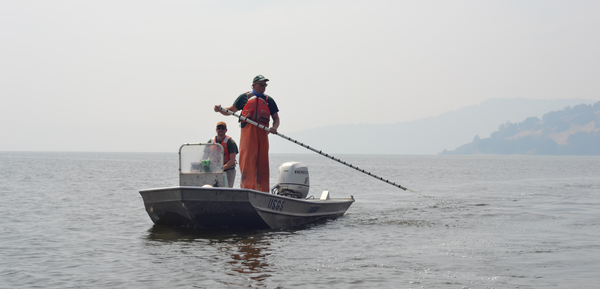 boat with USGS fisheries scientists on Upper Klamath Lake, OR
boat with USGS fisheries scientists on Upper Klamath Lake, OR
Juvenile Sucker Sampling on Upper Klamath Lake, OR
Juvenile Sucker Sampling on Upper Klamath Lake, ORThis is a video of fieldwork in Upper Klamath Lake, OR. Here, biologists sample for juvenile suckers, an endangered fish species in the lake.
Juvenile Sucker Sampling on Upper Klamath Lake, OR
Juvenile Sucker Sampling on Upper Klamath Lake, ORThis is a video of fieldwork in Upper Klamath Lake, OR. Here, biologists sample for juvenile suckers, an endangered fish species in the lake.
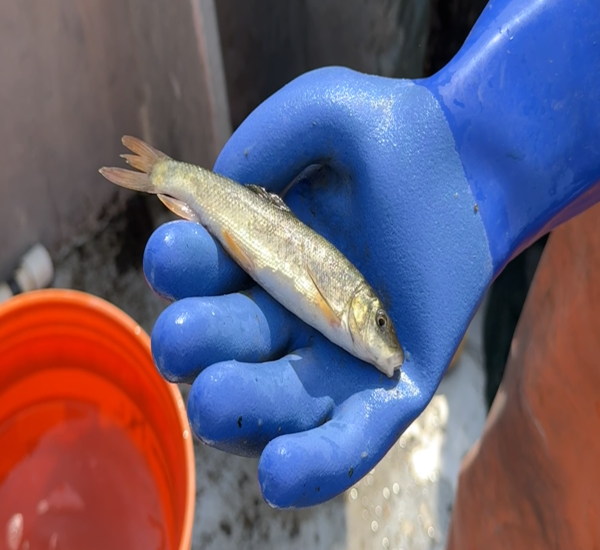 Endangered Klamath Sucker fish held in hand with glove above bucket of water
Endangered Klamath Sucker fish held in hand with glove above bucket of water
This is a video of a juvenile sucker in Upper Klamath Lake, OR. Through decades of research, scientists at the USGS Western Fisheries Research Center have determined that over the last 30 years something has prevented young suckers from reaching adulthood. Scientists work tirelessly to find the cause of this break in recruitment into adulthood.
This is a video of a juvenile sucker in Upper Klamath Lake, OR. Through decades of research, scientists at the USGS Western Fisheries Research Center have determined that over the last 30 years something has prevented young suckers from reaching adulthood. Scientists work tirelessly to find the cause of this break in recruitment into adulthood.
This is a video with Melanie Prentice and Grace Crandall on solving the mystery behind Sea Star Wasting Disease.
This is a video with Melanie Prentice and Grace Crandall on solving the mystery behind Sea Star Wasting Disease.
Fish health monitoring efforts in Upper Klamath Lake have revealed a high prevalence of warm water pathogens. The USGS Western Fisheries Research Center (WFRC) fish health team is investigating parasites as a potential threat to the vulnerable sucker populations.
Fish health monitoring efforts in Upper Klamath Lake have revealed a high prevalence of warm water pathogens. The USGS Western Fisheries Research Center (WFRC) fish health team is investigating parasites as a potential threat to the vulnerable sucker populations.
 Underwater views of common fish inhabiting eelgrass meadows in Skagit Bay, Washington
Underwater views of common fish inhabiting eelgrass meadows in Skagit Bay, Washington
Underwater Views of Common Fish Inhabiting Eelgrass Meadows in Skagit Bay, Washington
Underwater Views of Common Fish Inhabiting Eelgrass Meadows in Skagit Bay, WashingtonExplore the underwater world of Skagit Bay eelgrass meadows with this short video that shows off several fish species in their native environment. Observe the elegant Pacific Herring school gliding across the water, followed by the unusual Snake Prickleback.
Underwater Views of Common Fish Inhabiting Eelgrass Meadows in Skagit Bay, Washington
Underwater Views of Common Fish Inhabiting Eelgrass Meadows in Skagit Bay, WashingtonExplore the underwater world of Skagit Bay eelgrass meadows with this short video that shows off several fish species in their native environment. Observe the elegant Pacific Herring school gliding across the water, followed by the unusual Snake Prickleback.
Juvenile Coho salmon (Oncorhynchus kisutch) exhibiting abnormal behaviors associated with exposure to 6PPD-quinone, a derivative of the compound 6PPD which is used in tires to prevent wear.
Juvenile Coho salmon (Oncorhynchus kisutch) exhibiting abnormal behaviors associated with exposure to 6PPD-quinone, a derivative of the compound 6PPD which is used in tires to prevent wear.


